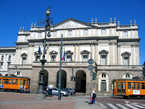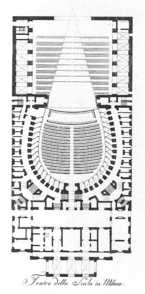Teatro alla Scala
Giuseppe Piermarini
via Filodrammatici 2, | |
| show on the map | http://www.teatroallascala.org/en/index.html |
Important events
People
History
On 26 February 1776 the old Teatro di Corte in Milan was burnt down. By 9 March a group of ninety box-holders met to plan a new one. Archduke Ferdinand, the Austrian ruler, favoured the enterprise, even urged the Milanese to build two theatres instead of one and suggested Giuseppe Piermarini as the architect.
Architecturally La Scala had nothing particularly new to offer. The facade was, and still is, judged to be too unemphatic, but one must remember that it was originally part of a street, not the focal point of a large public square. The charm of the interior, upon which generations of opera-goers are unanimous, owes as much to the carefully supervised details as to the general planning, though the sight-lines are well managed and the acoustics excellent.
There are six tiers of boxes. The parapet of each box was decorated according to an overall scheme worked out by Levati and Reina, who also painted the ceiling. But inside, the boxes were luxurious little private apartments, which could be cut off completely from the outside world by curtains, and which each box-holder could embellish according to his own taste. Some were fitted up in the frilliest Rococo, others in the severest classicism. That of the Meroni family, for instance, was painted by a pupil of Galliari with rural pictures recalling scenes from Cimarosa's operas. Others had gilded wood carving. On gala evenings, when everyone came to outshine their neighbours, the effect must have been dazzling. A few of these boxes remain intact, but many were ruined as early as 1796, when the short-lived Cisalpine Republic ordered the destruction of all heraldic insignia. Others perished in redecorations of 1807, 1830 and 1879. Finally in 1921 a rather drab uniformity was imposed, on the grounds that 'La Scala no longer has an aristocratic public, for whom the boxes were appendages to their mansions.' In fact, however, the records of box-holders show that even by 1840 nearly all of them were bourgeois. In the postwar reconstruction an attempt has been made to reinstate some of these boxes in their former glory.
The royal box occupies the most prominent place in the centre, with the main entry into the parterre (platea in Italian) beneath it. The stage is, as usual, flanked by pairs of giant columns holding tiers of 'proscenium boxes', topped by a section of classical entablature. This does not itself support the arch, however; that rests on pairs of enormous consoles springing from giant satyr heads.
Piermarini's stage, already large, was extended in 1814 by Canonica and Giusti, who took in some ground at the back belonging to a demolished monastery. In 1907 the orchestra pit was lowered, and throughout the years there has been a steady attrition of boxes and their replacement by rows of seats. Lighting was at first by candles on the parapets of the boxes, later improved by oil lamps with reflectors. In 1821 a large chandelier was installed with eighty-four oil lamps; in 1860 this was replaced by another using gas, which in i 884 was converted to electricity
La Scala, Milan, has been redecorated and restored many times, particularly after severe bombing in 1943. The royal box occupies its standard Continental position in the centre. This view makes very clear the limited seating capacity of the traditional opera house, a limitation that could only be overcome by making the theatre enormously big. Six tiers of boxes have been successfully integrated, but each is only two or three rows deep. Nothing more could be done until Ledoux's experiments with the amphitheatre bore fruit, or (a century later) cantilevering made possible deep projecting galleries.
In: Tidworth, Simon : Theatres: An Illustrated History. London 1973 p. 143 -144
The auditorium has 6 galeries with 146 private loges and a total seating capacity of 2309 spectators.
Author: Simon Tidworth
Simon Tidworth:
religious structures, Palais Garnier, Théâtre du Vieux-Colombier, Semper Opera House, Teatro alla Scala, Verona Philharmonic Theatre, Teatro El Buen Retiro, Malmö Municipal Theatre, People's Theatre, National Opera of Bordeaux, Musical Theatre of Besançon, Opernhaus auf der Cortina, Theatre Royal, The London Coliseum, Opernhaus in Salvatorplatz, Stuttgart State OperaAdditional information
No information has yet been entered
Add information































